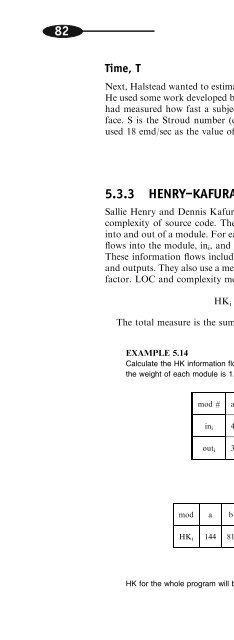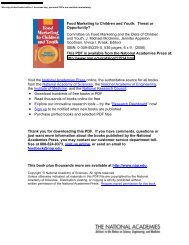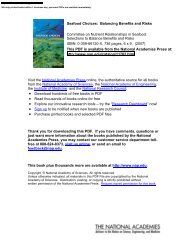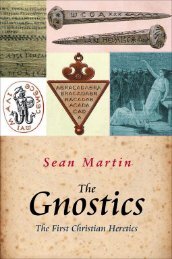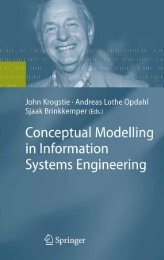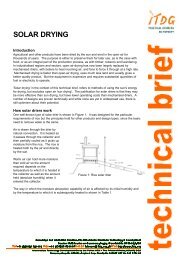- Page 1 and 2:
TEAMFLY
- Page 4:
SCHAUM’S OUTLINE OF Theory and Pr
- Page 8:
Theory and Problems of SOFTWARE ENG
- Page 12:
Software Engineering is not just su
- Page 16:
For more information about this boo
- Page 20:
CONTENTS ix 10.2 Software Testing F
- Page 24:
SCHAUM’S OUTLINE OF Theory and Pr
- Page 28:
The Software Life Cycle 1.1 Introdu
- Page 32:
CHAPTER 1 The Software Life Cycle 3
- Page 36:
CHAPTER 1 The Software Life Cycle 5
- Page 40:
Software Process and Other Models 2
- Page 44:
CHAPTER 2 Software Process and Othe
- Page 48:
CHAPTER 2 Software Process and Othe
- Page 52:
CHAPTER 2 Software Process and Othe
- Page 56:
CHAPTER 2 Software Process and Othe
- Page 60:
CHAPTER 2 Software Process and Othe
- Page 64:
CHAPTER 2 Software Process and Othe
- Page 68:
CHAPTER 2 Software Process and Othe
- Page 72:
CHAPTER 2 Software Process and Othe
- Page 76:
CHAPTER 2 Software Process and Othe
- Page 80:
CHAPTER 2 Software Process and Othe
- Page 84:
CHAPTER 2 Software Process and Othe
- Page 88:
CHAPTER 3 Software Project Manageme
- Page 92:
CHAPTER 3 Software Project Manageme
- Page 96:
CHAPTER 3 Software Project Manageme
- Page 100:
CHAPTER 3 Software Project Manageme
- Page 104:
CHAPTER 3 Software Project Manageme
- Page 108:
CHAPTER 3 Software Project Manageme
- Page 112:
CHAPTER 3 Software Project Manageme
- Page 116:
CHAPTER 3 Software Project Manageme
- Page 120:
Software Project Planning 4.1 Proje
- Page 124:
CHAPTER 4 Software Project Planning
- Page 128:
CHAPTER 4 Software Project Planning
- Page 132:
CHAPTER 4 Software Project Planning
- Page 136:
CHAPTER 4 Software Project Planning
- Page 140: CHAPTER 4 Software Project Planning
- Page 144: CHAPTER 4 Software Project Planning
- Page 148: CHAPTER 4 Software Project Planning
- Page 152: CHAPTER 4 Software Project Planning
- Page 156: CHAPTER 4 Software Project Planning
- Page 160: CHAPTER 4 Software Project Planning
- Page 164: CHAPTER 4 Software Project Planning
- Page 168: CHAPTER 4 Software Project Planning
- Page 172: CHAPTER 5 Software Metrics 73 ‘
- Page 176: CHAPTER 5 Software Metrics 75 examp
- Page 180: CHAPTER 5 Software Metrics 77 2 ¼
- Page 184: CHAPTER 5 Software Metrics 79 state
- Page 188: CHAPTER 5 Software Metrics 81 Volum
- Page 194: 84 3. Explain why money is a ratio
- Page 198: CHAPTER 5 Software Metrics 87 Answe
- Page 202: CHAPTER 5 Software Metrics 89 7. Ca
- Page 206: Risk Analysis and Management 6.1 In
- Page 210: CHAPTER 6 Risk Analysis and Managem
- Page 214: CHAPTER 6 Risk Analysis and Managem
- Page 218: CHAPTER 6 Risk Analysis and Managem
- Page 222: Software Quality Assurance 7.1 Intr
- Page 226: CHAPTER 7 Software Quality Assuranc
- Page 230: CHAPTER 7 Software Quality Assuranc
- Page 234: CHAPTER 7 Software Quality Assuranc
- Page 238: CHAPTER 7 Software Quality Assuranc
- Page 242:
CHAPTER 7 Software Quality Assuranc
- Page 246:
CHAPTER 7 Software Quality Assuranc
- Page 250:
CHAPTER 8 Requirements 113 EXAMPLE
- Page 254:
CHAPTER 8 Requirements 115 The esse
- Page 258:
CHAPTER 8 Requirements 117 Copy ID
- Page 262:
CHAPTER 8 Requirements 119 2.2 Prod
- Page 266:
CHAPTER 8 Requirements 121 3. What
- Page 270:
CHAPTER 8 Requirements 123 5. Draw
- Page 274:
CHAPTER 8 Requirements 125 10. Draw
- Page 278:
Software Design 9.1 Introduction De
- Page 282:
CHAPTER 9 Software Design 129 patro
- Page 286:
CHAPTER 9 Software Design 131 Abstr
- Page 290:
CHAPTER 9 Software Design 133 z=0;
- Page 294:
CHAPTER 9 Software Design 135 See F
- Page 298:
CHAPTER 9 Software Design 137 Tom a
- Page 302:
CHAPTER 9 Software Design 139 6.6 6
- Page 306:
CHAPTER 9 Software Design 141 Answe
- Page 310:
CHAPTER 9 Software Design 143 See F
- Page 314:
Software Testing 10.1 Introduction
- Page 318:
CHAPTER 10 Software Testing 147 In
- Page 322:
CHAPTER 10 Software Testing 149 val
- Page 326:
CHAPTER 10 Software Testing 151 cou
- Page 330:
CHAPTER 10 Software Testing 153 10.
- Page 334:
CHAPTER 10 Software Testing 155 The
- Page 338:
CHAPTER 10 Software Testing 157 EXA
- Page 342:
CHAPTER 10 Software Testing 159 10.
- Page 346:
CHAPTER 10 Software Testing 161 4.
- Page 350:
CHAPTER 10 Software Testing 163 Sta
- Page 354:
CHAPTER 10 Software Testing 165 if
- Page 358:
CHAPTER 10 Software Testing 167 See
- Page 362:
Object-Oriented Development 11.1 In
- Page 366:
CHAPTER 11 Object-Oriented Developm
- Page 370:
CHAPTER 11 Object-Oriented Developm
- Page 374:
CHAPTER 11 Object-Oriented Developm
- Page 378:
CHAPTER 11 Object-Oriented Developm
- Page 382:
CHAPTER 11 Object-Oriented Developm
- Page 386:
CHAPTER 11 Object-Oriented Developm
- Page 390:
Object-Oriented Metrics 12.1 Introd
- Page 394:
CHAPTER 12 Object-Oriented Metrics
- Page 398:
CHAPTER 12 Object-Oriented Metrics
- Page 402:
CHAPTER 12 Object-Oriented Metrics
- Page 406:
CHAPTER 12 Object-Oriented Metrics
- Page 410:
CHAPTER 12 Object-Oriented Metrics
- Page 414:
CHAPTER 12 Object-Oriented Metrics
- Page 418:
CHAPTER 12 Object-Oriented Metrics
- Page 422:
Object-Oriented Testing 13.1 Introd
- Page 426:
CHAPTER 13 Object-Oriented Testing
- Page 430:
CHAPTER 13 Object-Oriented Testing
- Page 434:
CHAPTER 13 Object-Oriented Testing
- Page 438:
CHAPTER 13 Object-Oriented Testing
- Page 442:
CHAPTER 14 Formal Notations 209 the
- Page 446:
CHAPTER 14 Formal Notations 211 lib
- Page 450:
CHAPTER 14 Formal Notations 213 3.
- Page 454:
CHAPTER 14 Formal Notations 215 Ans
- Page 458:
CHAPTER 14 Formal Notations 217 Cla
- Page 462:
Z 1 (see Operand) Z 2 (see Operator
- Page 466:
INDEX 221 Lack of Cohesion in Metho
- Page 470:
INDEX 223 Software metrics (see Met


